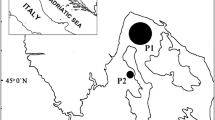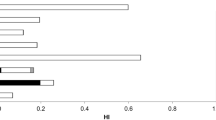Abstract
Methylmercury (MeHg) is a neurotoxic contaminant and one of the main sources of exposure in humans is seafood consumption. It is thus of interest to assess precisely MeHg exposure. The objective of this study was to estimate MeHg daily intake in exposed individuals using two different approaches, a food questionnaire and toxicokinetic modeling, and compare the complementary and use of each method. For this purpose, a group of 23 fishermen from northern Quebec provided blood and hair samples and answered a standard food questionnaire focusing on seafood consumption. A published and validated toxicokinetic model was then used to reconstruct MeHg daily intakes from mercury (Hg) measurements in biological samples. These intakes were compared to those estimated using a standard food questionnaire on seafood consumption. Daily intakes of MeHg from seafood (mean/median (range)) estimated from hair concentrations with the toxicokinetic-based approach were 6.1/5.2 (0.0–19) μg/day. These intake values were on average six times lower than those estimated using a food questionnaire, that is, 49/32 (7.2–163) μg/day. No correlation was found between the toxicokinetic-based and the questionnaire estimates of MeHg daily intakes. Most of the MeHg intakes estimated with the food questionnaire (21/23) exceeded the US EPA RfD of 0.1 μg/kg bw/day, whereas only a small proportion (6/23) of modeled estimates exceeded the RfD. This study shows that human health risk estimates strongly depend on the chosen approach.
This is a preview of subscription content, access via your institution
Access options
Subscribe to this journal
Receive 6 print issues and online access
$259.00 per year
only $43.17 per issue
Buy this article
- Purchase on Springer Link
- Instant access to full article PDF
Prices may be subject to local taxes which are calculated during checkout



Similar content being viewed by others
References
Aschner M., and Syversen T. Methylmercury: recent advances in the understanding of its neurotoxicity. Ther Drug Monit 2005: 27 (3): 278–283.
Barceloux D.G. Selenium. J Toxicol Clin Toxicol 1999: 37 (2): 145–172.
Belanger M.C., Mirault M.E., Dewailly E., Berthiaume L., and Julien P. Environmental contaminants and redox status of coenzyme Q10 and vitamin E in Inuit from Nunavik. Metabolism 2008: 57 (7): 927–933.
Bjornberg K.A., Vahter M., Grawe K.P., and Berglund M. Methyl mercury exposure in Swedish women with high fish consumption. Sci Total Environ 2005: 341 (1-3): 45–52.
Block G., Hartman A.M., Dresser C.M., Carroll M.D., Gannon J., and Gardner L. A data-based approach to diet questionnaire design and testing. Am J Epidemiol 1986: 124 (3): 453–469.
Cabanero A.I., Carvalho C., Madrid Y., Batoreu C., and Camara C. Quantification and speciation of mercury and selenium in fish samples of high consumption in Spain and Portugal. Biol Trace Elem Res 2005: 103 (1): 17–35.
Cabanero A.I., Madrid Y., and Camara C. Mercury-selenium species ratio in representative fish samples and their bioaccessibility by an in vitro digestion method. Biol Trace Elem Res 2007: 119 (3): 195–211.
Cade J., Thompson R., Burley V., and Warm D. Development, validation and utilisation of food-frequency questionnaires — a review. Public Health Nutr 2002: 5 (4): 567–587.
Carrier G., Bouchard M., Brunet R.C., and Caza M. A toxicokinetic model for predicting the tissue distribution and elimination of organic and inorganic mercury following exposure to methyl mercury in animals and humans. II. Application and validation of the model in humans. Toxicol Appl Pharmacol 2001a: 171 (1): 50–60.
Carrier G., Brunet R.C., Caza M., and Bouchard M. A toxicokinetic model for predicting the tissue distribution and elimination of organic and inorganic mercury following exposure to methyl mercury in animals and humans. I. Development and validation of the model using experimental data in rats. Toxicol Appl Pharmacol 2001b: 171 (1): 38–49.
CHUL-CHUQ. Guide alimentaire du Saint-Laurent. Unité de recherche en santé publique. Centre de recherche du Centre Hospitalier de l′Université Laval et Saint-Laurent Vision 2000, Québec, 2003.
Dabeka R., McKenzie A.D., Forsyth D.S., and Conacher H.B. Survey of total mercury in some edible fish and shellfish species collected in Canada in 2002. Food Addit Contam 2004: 21 (5): 434–440.
Dabeka R.W., McKenzie A.D., and Bradley P. Survey of total mercury in total diet food composites and an estimation of the dietary intake of mercury by adults and children from two Canadian cities, 1998-2000. Food Addit Contam 2003: 20 (7): 629–638.
Dewailly E., Ayotte P., Bruneau S., Lebel G., Levallois P., and Weber J.P. Exposure of the Inuit population of Nunavik (Arctic Quebec) to lead and mercury. Arch Environ Health 2001: 56 (4): 350–357.
Folven K.I., Glover C.N., Malde M.K., and Lundebye A.-K. Does selenium modify neurobehavioural impacts of developmental methylmercury exposure in mice? Environ Toxicol Pharmacol 2009: 28 (1): 111–119.
Gosselin N.H., Brunet R.C., Carrier G., Bouchard M., and Feeley M. Reconstruction of methylmercury intakes in indigenous populations from biomarker data. J Expo Sci Environ Epidemiol 2006: 16 (1): 19–29.
Harkey M.R. Anatomy and physiology of hair. Forensic Sci Int 1993: 63 (1-3): 9–18.
Health Canada. Review of the Tolerable Daily Intake for Methylmercury: rationale for Proposed Interim Revision of the TDI. Health Canada, Ottawa, 1998.
Hydro-Québec. Guide de consommation des poissons pour les plans d’eau des régions du complexe La Grande, de la Grande rivière de la Baleine et de la Petite rivière de la Baleine. Hydro-Québec et Centre hospitalier de l’Université Laval, Unité de recherche en santé publique, Montréal, 2001.
Iwasaki Y., Sakamoto M., Nakai K., Oka T., Dakeishi M., and Iwata T., et al. Estimation of daily mercury intake from seafood in Japanese women: Akita cross-sectional study. Tohoku J Exp Med 2003: 200 (2): 67–73.
Johnsson C., Schutz A., and Sallsten G. Impact of consumption of freshwater fish on mercury levels in hair, blood, urine, and alveolar air. J Toxicol Environ Health A 2005: 68 (2): 129–140.
Kosatsky T., Przybysz R., and Armstrong B. Mercury exposure in Montrealers who eat St. Lawrence River sportfish. Environ Res 2000: 84 (1): 36–43.
Kutting B., Uter W., and Drexler H. The association between self-reported acrylamide intake and hemoglobin adducts as biomarkers of exposure. Cancer Causes Control 2008: 19 (3): 273–281.
Magkos F., Manios Y., Babaroutsi E., and Sidossis L.S. Development and validation of a food frequency questionnaire for assessing dietary calcium intake in the general population. Osteoporos Int 2006: 17 (2): 304–312.
Mahaffey K.R. Fish and shellfish as dietary sources of methylmercury and the omega-3 fatty acids, eicosahexaenoic acid and docosahexaenoic acid: risks and benefits. Environ Res 2004: 95 (3): 414–428.
Mahaffey K.R., Clickner R.P., and Bodurow C.C. Blood organic mercury and dietary mercury intake: National Health and Nutrition Examination Survey, 1999 and 2000. Environ Health Perspect 2004: 112 (5): 562–570.
Mannisto S., Virtanen M., Mikkonen T., and Pietinen P. Reproducibility and validity of a food frequency questionnaire in a case-control study on breast cancer. J Clin Epidemiol 1996: 49 (4): 401–409.
Mieiro C.L., Pacheco M., Pereira M.E., and Duarte A.C. Mercury distribution in key tissues of fish (Liza aurata) inhabiting a contaminated estuary-implications for human and ecosystem health risk assessment. J Environ Monit 2009: 11 (5): 1004–1012.
Miller T.M., Abdel-Maksoud M.F., Crane L.A., Marcus A.C., and Byers T.E. Effects of social approval bias on self-reported fruit and vegetable consumption: a randomized controlled trial. Nutr J 2008: 7: 18.
Muckle G., Ayotte P., Dewailly E., Jacobson S.W., and Jacobson J.L. Determinants of polychlorinated biphenyls and methylmercury exposure in inuit women of childbearing age. Environ Health Perspect 2001a: 109 (9): 957–963.
Muckle G., Ayotte P., Dewailly E.E., Jacobson S.W., and Jacobson J.L. Prenatal exposure of the northern Quebec Inuit infants to environmental contaminants. Environ Health Perspect 2001b: 109 (12): 1291–1299.
Natarajan L., Flatt S.W., Sun X., Gamst A.C., Major J.M., and Rock C.L., et al. Validity and systematic error in measuring carotenoid consumption with dietary self-report instruments. Am J Epidemiol 2006: 163 (8): 770–778.
Navarro-Alarcon M., and Cabrera-Vique C. Selenium in food and the human body: a review. Sci Total Environ 2008: 400 (1-3): 115–141.
Neuhouser M.L., Tinker L., Shaw P.A., Schoeller D., Bingham S.A., and Horn L.V., et al. Use of recovery biomarkers to calibrate nutrient consumption self-reports in the Women's Health Initiative. Am J Epidemiol 2008: 167 (10): 1247–1259.
O’Brien A., Fries E., and Bowen D. The effect of accuracy of perceptions of dietary-fat intake on perceived risk and intentions to change. J Behav Med 2000: 23 (5): 465–473.
Osowski J.M., Beare T., and Specker B. Validation of a food frequency questionnaire for assessment of calcium and bone-related nutrient intake in rural populations. J Am Diet Assoc 2007: 107 (8): 1349–1355.
Rohrmann S., and Becker N. Development of a short questionnaire to assess the dietary intake of heterocyclic aromatic amines. Public Health Nutr 2002: 5 (5): 699–705.
Sanzo J., Dorronsoro M., Amiano P., Amurrio A., Aguinagalde F., and Azpiri M., et al. Estimation and validation of mercury intake associated with fish consumption in an EPIC cohort of Spain. Public Health Nutr 2001: 4 (05): 981–988.
Satia J.A., King I.B., Morris J.S., Stratton K., and White E. Toenail and plasma levels as biomarkers of selenium exposure. Ann Epidemiol 2006: 16 (1): 53–58.
Schetagne R., Therrien J., and Lalumière R. Suivi environnementale du complexe La Grande. Évolution des teneurs en mercure dans les poissons. Groupe conseil Génivar Inc. et Direction Barrages et Environnement, Hydro-Québec Production, Montreal, 2002.
Sherlock J., Hislop J., Newton D., Topping G., and Whittle K. Elevation of mercury in human blood from controlled chronic ingestion of methylmercury in fish. Hum Toxicol 1984: 3 (2): 117–131.
Sirot V., Guerin T., Mauras Y., Garraud H., Volatier J.L., and Leblanc J.C. Methylmercury exposure assessment using dietary and biomarker data among frequent seafood consumers in France CALIPSO study. Environ Res 2008: 107 (1): 30–38.
Stern A.H. Estimation of the interindividual variability in the one-compartment pharmacokinetic model for methylmercury: implications for the derivation of a reference dose. Regul Toxicol Pharmacol 1997: 25 (3): 277–288.
Sunde R.A., Paterson E., Evenson J.K., Barnes K.M., Lovegrove J.A., and Gordon M.H. Longitudinal selenium status in healthy British adults: assessment using biochemical and molecular biomarkers. Br J Nutr 2008: 99 (Suppl. 3): S37–S47.
Trasande L., Landrigan P.J., and Schechter C. Public health and economic consequences of methyl mercury toxicity to the developing brain. Environ Health Perspect 2005: 113 (5): 590–596.
US EPA. Methylmercury (MeHg) (CASRN 22967-92-6). US Environmental Protection Agency: Washington, DC, 2001.
WHO. Methylmercury, Environmental Health Criteria 101. International Programme on Chemical Safety (IPCS) World Health Organization, Geneva, 1990.
Willett W. Nutritional Epidemiology. Oxford University Press, New York; Toronto, 1990.
Xue F., Holzman C., Rahbar M.H., Trosko K., and Fischer L. Maternal fish consumption, mercury levels, and risk of preterm delivery. Environ Health Perspect 2007: 115 (1): 42–47.
Acknowledgements
This study was supported and funded in part by Hydro-Québec, Quebec, Canada. We also thank Nathalie H. Gosselin for her helpful modeling inputs. This study was approved by the Human Research Ethics Board of the Faculty of Medicine of the Université de Montréal.
Author information
Authors and Affiliations
Corresponding author
Ethics declarations
Competing interests
The authors declare no conflict of interest.
Rights and permissions
About this article
Cite this article
Noisel, N., Bouchard, M., Carrier, G. et al. Comparison of a toxicokinetic and a questionnaire-based approach to assess methylmercury intake in exposed individuals. J Expo Sci Environ Epidemiol 21, 328–335 (2011). https://doi.org/10.1038/jes.2010.33
Received:
Accepted:
Published:
Issue Date:
DOI: https://doi.org/10.1038/jes.2010.33
Keywords
This article is cited by
-
Human Health Risks Derived from Dietary Exposure to Toxic Metals in Catalonia, Spain: Temporal Trend
Biological Trace Element Research (2014)



